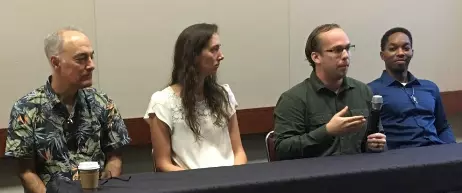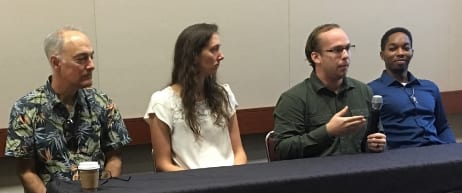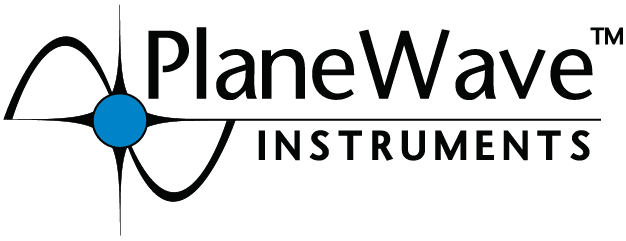CubeSat Astronomy in the 2020s

Room 301B, Hawaii Convention Center
Workshop during the 235th meeting of the American Astronomical Society Honolulu, Hawaii, Saturday, January 4, 2020, 8:30 am – 5:00 pm Room 301B, Hawaii Convention Center

Organizers
Russell Genet, California Polytechnic State University, 805.438.3305, rgenet@calpoly.edu Mary Knapp, Massachusetts Institute of Technology, 617.715.5563, mkanpp@mit.edu
Workshop Synopsis Thanks to NASA’s support, an increasing number of CubeSat astronomical research telescopes are in orbit or under development. Over the coming decade, CubeSat astronomical research telescopes—thanks to likely advances in technology, commercial quantity production, and lower launch costs—should help create a synergistic balance between large and small space telescopes similar to what has already been achieved between large and small ground-based robotic telescopes.
Numerous, low cost CubeSat telescopes could, for instance, not only enhance research opportunities for professional astronomers and their graduate students, but they could also open up research opportunities to undergraduate and high school students as well as citizen scientists. Technology advances over the next decade could provide totally autonomous CubeSat telescope operation, extend their wavelength coverage to the infrared and soft X-ray, and provide larger apertures.
The workshop was organized as four 90-minute sessions: (1) Introduction / Astronomy CubeSats in Orbit, (2) Astronomy CubeSats Under Development, (3) Future Expansion to Student and Citizen Science Research, and (4) Future Advances in CubeSat Telescope Technology. Each session consisted of 15- minute invited PowerPoint talks followed by a 15-minute Panel Discussion / Q&A. Session speakers were the panel members. There was also be two half-hour poster sessions with refreshments.
Agenda
830 Session I: Introduction / Astronomy CubeSats in Orbit
The workshop will open with NASA’s summary of the current status and potential future of CubeSats and their larger SmallSats cousins. Astronomy CubeSats currently in orbit will then be described.
830 Russ Genet (Cal Poly) and Mary Knapp (MIT), Call to Order and Announcements840 Kevin Iott, PlaneWave Instruments, Welcome from the Workshop’s Sponsor845 Michael Garcia, Science Mission Directorate NASA Headquarters, NASA Astrophysics CubeSats and SmallSats: Current and Future Prospects900 Vanessa Bailey, Jet Propulsion Lab, Arcsecond Space Telescope Enabling Research in Astrophysics (ASTERIA) 915 Chistopher Moore, Harvard-Smithsonian CfA, The Miniature X-ray Solar Spectrometer (MinXSS) CubeSats
930 Daniel LaRocca, University of Iowa, HaloSat: Searching for a Hot Baryon Gas Galactic Halo
945 Panel discussion Q&A / Moderator: Knapp / Panel members: Garcia, Bailey, Moore, and LaRocca1000: Morning Poster Discussions (30 minutes with refreshments)
1030 Session II: Astronomy CubeSats Under DevelopmentThe success of ASTERIA and other astronomy CubeSats in orbit has sparked a second generation of astronomy CubeSats currently under development.1030 Kevin France, Univ. of Colorado, Boulder, The Colorado Ultraviolet Transit Experiment (CUTE): Exploring Extreme Exoplanets
1045 Paul Goldsmith, Jet Propulsion Laboratory, COSMMIC – CO Surveyor using a MMIC Low Noise Receiver on a CubeSat
1100 Paul Scowen, Arizona State University, Star-Planet Activity Research CubeSat (SPARCS)
1115 Mary Knapp, MIT Haystack Observatory, Low Frequency Radio Observations
1130 Jeremy Perkins, NASA Goddard SFC, BurstCube: A CubeSat for Gravitational Wave Counterparts
1145 Panel discussion Q&A / Moderator: Knapp / Panel members: France, Goldsmith, Scowen, and Perkins.
1200 Lunch (90 minutes)
Session III: Future Expansion to Student and Citizen Science Research
Looking toward a future when astronomy CubeSats will be plentiful, low in cost, and highly capable, we should then be able to extend their use in research from professional astronomers and their graduate students, to undergraduate and high school students as well as citizen scientists.
130 Russell Genet, California Polytechnic State University, Robotic Telescopes and Student Research
145 Beatrice Millar, Stanford Online High School, Citizen Science with Stanford Online High School
200 Rachel Freed, Institute for Student Astronomical Research, Student Astronomical Research – Filling the Void with CubeSats
215 Jonathan Arenberg, Northrop Grumman Aerospace Systems, Stella Splendida: Building the science and engineering workforce of the 21st Century
230 Marc Kuchner, NASA Goddard Space Flight Center, Building the NASA Citizen Science Community
245 Robert Zellem, JPL, and Quinn Perian and Sujay Nair, Stanford Online High School, Exoplanet Transit Timing Initiative
300 Panel discussion Q&A / Moderator: Genet / Panel members: Millar, Freed, Arenberg, Kuchner, Zellem, Perian, and Nair
3:15 Afternoon Poster Discussions (30 minutes with refreshments)
345 Session IV: Future Advances in CubeSat Telescope Technology
For future constellations of astronomy CubeSats to be affordable, they will need to operate autonomously. Larger apertures and extension of their spectral coverage into the infrared and soft X-ray would increase their scientific value.
345 Rashied Amini, Jet Propulsion Lab, Making CubeSats Autonomous – the Easy Way
400 Gurmehar Singh, Stanford Online High School, CubeSat Radio Interferometry Space Telescope Array: CRISTA
415 Duncan Farrah, University of Hawaii, Extending CubeSat telescopes into the infrared
430 David Allred, Brigham Young University, Mirror coatings for EUV and soft X-Ray imaging
445 Panel discussion Q&A / Moderator: Genet / Panel members: Amini, Singh, Farrah, Allred, and Sheikh 500 Adjourn
Posters
Stanford Online High School Student Posters
Photometric Effects on Astrometry of Close Double Stars, Ryan Caputo, Caroline Wiess, and Kalée Tock Z-Factor: An Escape-Velocity Metric for Assessing the Likelihood of Gravitational Relationship Between Stars, Zach Haarz and Kalée Tock
Freshening Exoplanet Transit Midpoints, Quinn Perian, Sujay Nair, and Kalée Tock
High-Altitude Ballooning with Stanford Online High School, Kalée TockUsing Machine Learning to Analyze Pulsar Plots, Gurmehar Singh and Beatrice Millar
Other Posters
Understanding the High-Energy Radiation Emission of Low-Mass Stars: Constructing Stellar Models Using SPARCS Photometry, Sarah Peacock1, Travis Barman2, Evgenya Shkolnik3, David Ardila4, Matthew Beasley5, Judd Bowmane3, Johnathan Gamaunt3, Dawn Gregory6, Valentin Ivanitski6, Daniel Jacobs3, Logan Jensen3, April Jewell4, Joe Llama7, Victoria Meadows8, Shouleh Nikzad9, Mary Osmond Juelfse3, Tahina Ramiaramanantsoa3, Paul Scowen3, Nathaniel Struebele3, Mark Swain4,
1. University of Arizona, 2. Lunar and Planetary Lab, University of Arizona, 3. Arizona State University, 4. Jet Propulsion Laboratory, 5. Southwest Research Institute, 6. AZ Space Technologies, 7. Lowell Observatory, 8. University of Washington
Battery-Powered In-Space Reflective Coating Technology, David Sheikh, ZeCoat Corporation
Stanford Online High School Students Giving Presentations

University of Hawaii Undergraduate Student Participants

Panels




